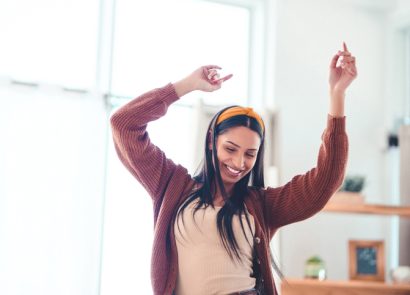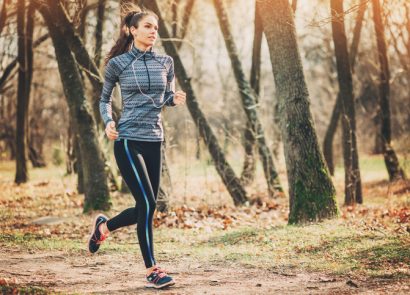Stress is a state of mind and body that occurs when we take on more responsibilities than we can deal with, or when we find ourselves in a state of helplessness when dealing with a crisis. Anxiety and stress can also arise when we find ourselves trapped in a stagnant routine which seems to offer no hope of improvement. In these situations, we can become detached from our feelings as we block them out, and both the body and mind can become insensitive to hardship and tiredness, resulting in chronic stress. Regular yoga can help us become aware of, and sensitive to, our body and mind, therefore noticing any hidden tiredness, pain or stress. By paying attention to your breathing while practising yoga postures, we can reconnect to our physical and mental state, detect our needs and weaknesses and respond to them. The following exercises can be done on a daily basis and will help to gradually reduce stress, anxiety and fatigue as well as the physical symptoms commonly associated with them, such as insomnia, headaches and neck and back tension.
As well as a regular yoga practice to help reduce stress, Swami Purohit recommends taking care of your diet by reducing stimulants such as coffee, alcohol and sugar, eating lots of seasonal fruits and vegetables, taking plenty of rest and, if possible, going to bed and getting up at about the same time every day. If you have trouble going to sleep, try having a warm bath or drinking a glass of hot milk just before going to bed. Beating stress and anxiety requires a holistic approach, as so many lifestyle factors are involved.
Quick fix
If at any time you feel overwhelmed by stress or anxiety, try this quick stress-busting exercise:
1. Lie down for 10 minutes, keep your body loose and relaxed, close your eyes and place your arms by your sides with your palms facing the sky.
2. Pay attention to your breathing; feel how you inhale and exhale through your nostrils (your mouth should be closed). Do this for 10 minutes – it might be useful to set an alarm as you may fall asleep!
Swami purohit (Swamiji)
Swami Purohit (Swamiji) is an inspirational yoga and meditation expert with over 40 years’ experience in the yogic disciplines of meditation, hatha yoga and mantra. Since 2006, Swamiji has been guiding groups and individuals in Spain, Belgium, France and soon in the UK, helping them to transform their vision into action and create a meaningful life by practising yoga and meditation. Stay up-to-date at swamipurohit.com/en
Balasana (Child pose)
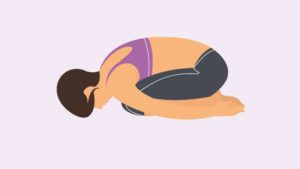
This asana takes it’s name from the Sanskrit words ‘bala’, which means child, and ‘asana’, meaning pose. It reduces back and neck tension, which occur so commonly when we are stressed. Try to focus on your breathing while doing this exercise.
1. Kneel down with your hands and knees on the floor. Use a yoga mat or similar for comfort. Relax and feel your toes against the floor, then separate your knees to the same width as your hips. As you exhale, gently lower your glutes down to your heels, feeling how the base of your spine stretches out as you do so. Bend your torso forward towards your thighs, stretching as you go, moving gently until your forehead reaches the floor, or as near to it as is comfortable for you. Your arms should be at your sides, hands by your feet, palms facing upwards. Breathe slowly in and out several times and keep your back low. Stay in this position for as long as is comfortable, up to a maximum of five minutes, and pay attention to each inhalation and exhalation.
2. To come out of the pose, breathe in and stretch your torso forwards, rising gradually as the base of your spine presses down through your pelvis, towards your heels.
Setu bandha sarvangasana (Bridge pose)
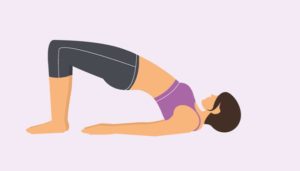
This pose relaxes the brain and reduces stress, anxiety and mild depression. It is also believed to help lower blood pressure and reduce thyroid imbalances.
1. Lie on your back with your arms by your sides and breathe deeply. Bend your knees and bring your feet closer to your body, so that you can just reach your heels with the tips of your fingers, or as near as possible. Your feet should be slightly apart. Stretch your body and place your hands at your sides.
2. Breathe deeply while you raise your hips off the floor, creating a straight line between your knees and your shoulders. Place your arms beneath your body and link the fingers of both hands together.
3. Now, raise your hips as far as possible, keeping your feet flat on the floor. Hold for 15 seconds and relax. Repeat three or four times, resting for 10 seconds between repetitions.
Uttasana (Standing forward bend)
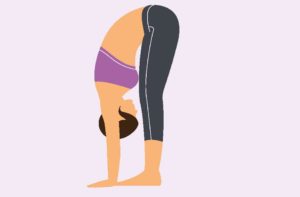
This pose relieves headaches, anxiety, fatigue and insomnia, as well as strengthening the knees and thighs. It can also have beneficial effects for women experiencing the symptoms of menopause.
1. From a standing position, raise your arms in front of you. Exhale and bend forward from your hips, not from your waist. The emphasis should be on stretching your torso a little more as you gradually bend forwards. If possible, keeping your legs straight, place your palms, or the tips of your fingers, on the floor, either beside, or in front of your feet. Alternatively, you can place your hands behind your heels. If you are unable to do this, cross your forearms and hold your elbows. With each inhalation, raise and lengthen your torso, and with each exhalation release yourself forward into the pose a little more. Your body will oscillate very slightly with each breath. Keep your head and neck relaxed.
2. Hold the pose for 30 to 60 seconds. Rest and repeat several times.
Marjaryasana (Cat pose)
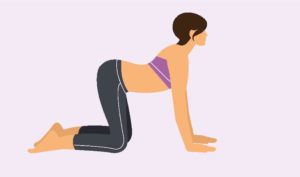
Marjaryasana relieves back pain, as well as neck tension and headaches. It improves blood flow in the spine which reduces feelings of stress. As well as being a great stretch for the back, this posture gently massages the belly organs which activates and stimulates them.
1. Start on your hands and knees in a tabletop position. Make sure your knees are set directly below your hips and your wrists, elbows and shoulders are in line and perpendicular to the floor. Place your head in a comfortable position, eyes looking down at the floor.
2. As you exhale, round your spine towards the ceiling, making sure to keep your shoulders and knees in position. Release your head towards the floor, but don’t force your chin to your chest.
3. Inhale, coming back to the tabletop position on your hands and knees.
Navasana (Boat pose)
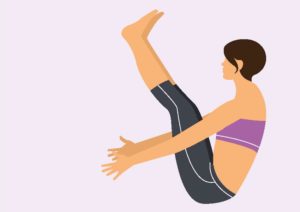
Navasana strengthens the abdominal muscles and improves liver and kidney function. It also increases blood circulation and balances the hormonal system, two benefits which help to reduce stress, fatigue and anxiety.
1. Begin in a seated position with your knees bent and your feet flat on the floor. Lift your feet off the floor, keeping your knees bent at first, and bring your shins parallel to the floor – this is the half boat pose. Your torso will naturally fall back, but don’t let your spine curve round.
2. Straighten your legs to a 45-degree angle (if you can do so without losing the integrity of your upper body). The aim is to keep your torso as upright as possible so that it makes a V-shape with your legs. Roll your shoulders back and straighten your arms roughly parallel to the floor with your palms turned up. Balance on your ‘sitting bones’.
3. Hold the pose for at least five breaths then release your legs on an exhalation. Finally, inhale and sit up.
Sukhasana (Easy pose)
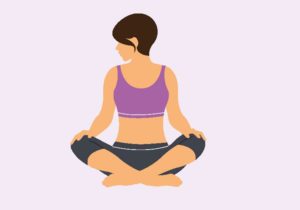
This pose is all about sitting quietly, in stillness, and focusing on your breathing. This is a way of calming your mind, quietening all the mental chatter and bringing a sense of peace and wellbeing to your day.
1. Sit on the floor, keeping your back perpendicular to the ground. Cross your legs by sliding each foot beneath the thigh of the opposite leg. Adjust the pose until you feel comfortable. There should be no pressure or discomfort anywhere. Keep your shoulders, neck, spine and head straight.
2. Place your hands on your knees with your palms facing up or down, depending on which way is more comfortable. Focus on your breathing for at least three minutes before releasing the pose.
Shavasana (Relaxation pose)
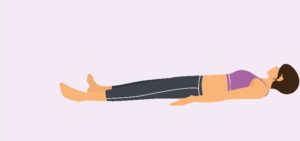
Also known as the ‘corpse pose’, this is the perfect way to end your yoga practice. It creates a great sense of relaxation and calm in the mind and body.
1. Lie on your back, with your legs and arms stretched out and relaxed. Release all of your muscles and breathe gently and normally.
2. Close your eyes and stay in this position for at least five minutes.













